Oakland 2024 crime trends are mixed, but CHP efforts are delivering significant impact
Compared to 2023, homicides and firearm assaults are down 10-20%, but residential robberies have doubled. For other crimes, the data is still unclear.
Oakland’s tragic mass shooting on Juneteenth felt inevitable to many who watch unchecked crime and lawlessness unfold daily.
That evening, OPD had 15 officers attending to a homicide in East Oakland at the same time that the violence was erupting at Lake Merritt. It left only 15 officers to control a crowd of thousands of people, many of whom were likely intoxicated given the unlicensed and pervasive sale of alcohol and drugs by some street vendors. There is no law enforcement agency in the world that can manage such a situation with so few personnel.
Yet city leaders say that crime is falling. Many residents find this implausible, but is it true?
While leaders claim that crime is down by 33%, they are comparing final crime totals of 2023 to incompletely counted crime totals for 2024. Crime data takes as long as 8 weeks to tabulate by OPD. And the underreporting error at this time last year was 35%, suggesting that the observed decrease is just a reflection of that underreporting error.
Using an apples-to-apples comparison of the of 2023 and 2024 year-to-date data, as it was initially reported, the picture looks quite different.
On one hand, there are some clear positive trends—homicide and firearm assaults are down from last year, and some clear negative ones—residential robbery has doubled from last year.
On the other hand, we don’t have accurate data yet for other categories of violent crime, nor for non-violent property crimes. All changes in those crimes are within the margin of reporting error, and we cannot draw any conclusions. The same is true for total crime rate, which aggregates these uncertain categories.
We look at the data behind these observations, and the additional data showing that the California Highway Patrol (CHP) deployment to Oakland is beginning to make a difference.
Have violent crime rates changed from 2023 to 2024?
Residential robbery appears to have doubled since last year; homicide is down about 11%; and firearm assault is down about 21%.
The typical reporting error in homicides, assault, and robbery is only 3-8% in most years (albeit it was larger last year). So the observed changes in robbery, homicide and assault are most likely real—not due to reporting errors—even when accounting for last year’s unusually large error.
Other violent crimes appear unchanged compared to last year (see Appendix), at least within the margin of error.
The root causes for the improvements in homicide and firearm assault have not been determined. But intensified investigations may have had some impact. We note, in particular, that the homicide clearance rate (solved cases) rose to 62 last year—that’s 20% higher than the average case closure rate for the past 8 years. And California Highway Patrol assistance may also be contributing (see below).
Have property crime rates changed from 2023 to 2024?
For non-violent property crimes, including burglaries, larceny, and motor vehicle theft, the picture is less clear. It appears that all are tracking about the same as last year—but we can’t know for sure.
Property crimes receive less priority in the resource-limited police department. Thus, they are subject to larger initial undercounting errors. This is particularly so for burglary, which had a severe undercounting error last year. Initial counts were more than 50% below final tallies. No doubt, this undercount was exacerbated by frenzied pace of crime—17,000 burglaries occurred last year, which is more than double the count in 2020.
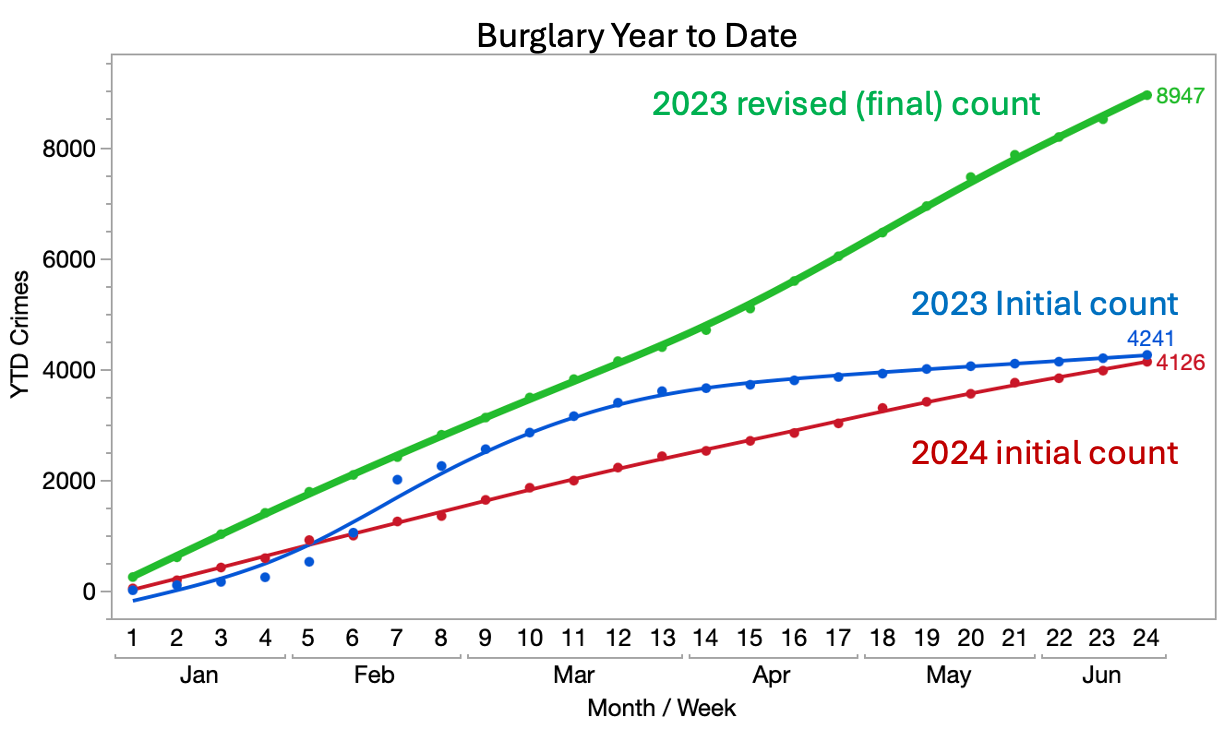
Thus, this large and uncertain error makes it impossible to conclude what is happening with property crime trends. We won’t have a more confident picture on property crimes until mid-late autumn.
Despite the uncertainty, there are some reasons why we might see improvements in property crime as the year progresses. OPD tripled their burglary investigators from 2 to 6 in 2024. According to a senior city official (personal communication), arrests went from near zero last year to several per week this year. This may suggest that burglaries are in route to a lower total. Only time will tell.
Additional figures may be viewed here on other crimes. The full data set, which is extracted from 8 years of OPD PDF crime reports, is available for download.
Has the increased presence of California Highway Patrol had any benefit?
Last February, Governor Gavin Newsom deployed a surge of 120 CHP officers to help Oakland combat its crime problem. In June, results from that operation were announced—440 arrested on felony and misdemeanor charges, 887 stolen vehicles recovered, and 47 crime-linked firearms confiscated. That represents about 18% of the ~2400 annual arrests reported at this time in 2023, and 10% of the ~8,900 vehicles stolen by this time last year.
That’s a significant contribution to crime fighting. But then why is there seemingly little evidence of impact on the total crime trends, as discussed above?
The first reason is that tabulation error may be obscuring our view. The impact of CHP efforts may yet become visible as those errors decrease over the rest of the year.
The second reason is the scale of the deployment. While there may have been 120 CHP officers deployed in the first week, it was scaled down soon thereafter. An unnamed source in the city said that CHP now has one squad of 6-8 officers deployed to Oakland for one shift per week. At that scale, even an extremely effective unit cannot turn the tide on Oakland crime, particularly if the city further reduces officer count as proposed.
Two of the most significant deterrents of future crime are: (1) incapacitation of criminal activity by removing repeat offenders from the streets—50% of crimes are committed by 2-5% of criminals; (2) the certainty of getting caught. For either to significantly affect crime rates, elevated enforcement activity and a higher and more visible police presence will be needed for many months and years. With ~35 OPD patrol officers at any given time, plus one CHP squad per week for one shift, there just aren’t sufficient police resources to tip the scales on police presence and enforcement.
This lack of resources contributed to the tragedy on Juneteenth.
Despite these resource limitations, the CHP impact is not nothing. This is, in part, because they harness CHP’s region-wide intelligence, and coordinate in real time with OPD to maximize their impact.
For example, the CHP unit helped OPD intercept a roving sideshow caravan on Saturday, June 15. That caravan began by causing mayhem in San Jose early Saturday evening, including vandalizing police cars. CHP communicated to OPD that the caravan began heading toward Grand Avenue in Oakland, and OPD was able to quickly deploy a surge of units to blockade the area before the caravan arrived. They successfully diverted the cars and avoided a dangerous sideshow. In another instance, the CHP unit set up a DUI choke point on a road in East Oakland where they picked up and arrested a major sideshow promoter.
The unnamed city source said the CHP unit is “punching far above their weight” and their work has a “multiplier effect” in maintaining the peace.
Appendix
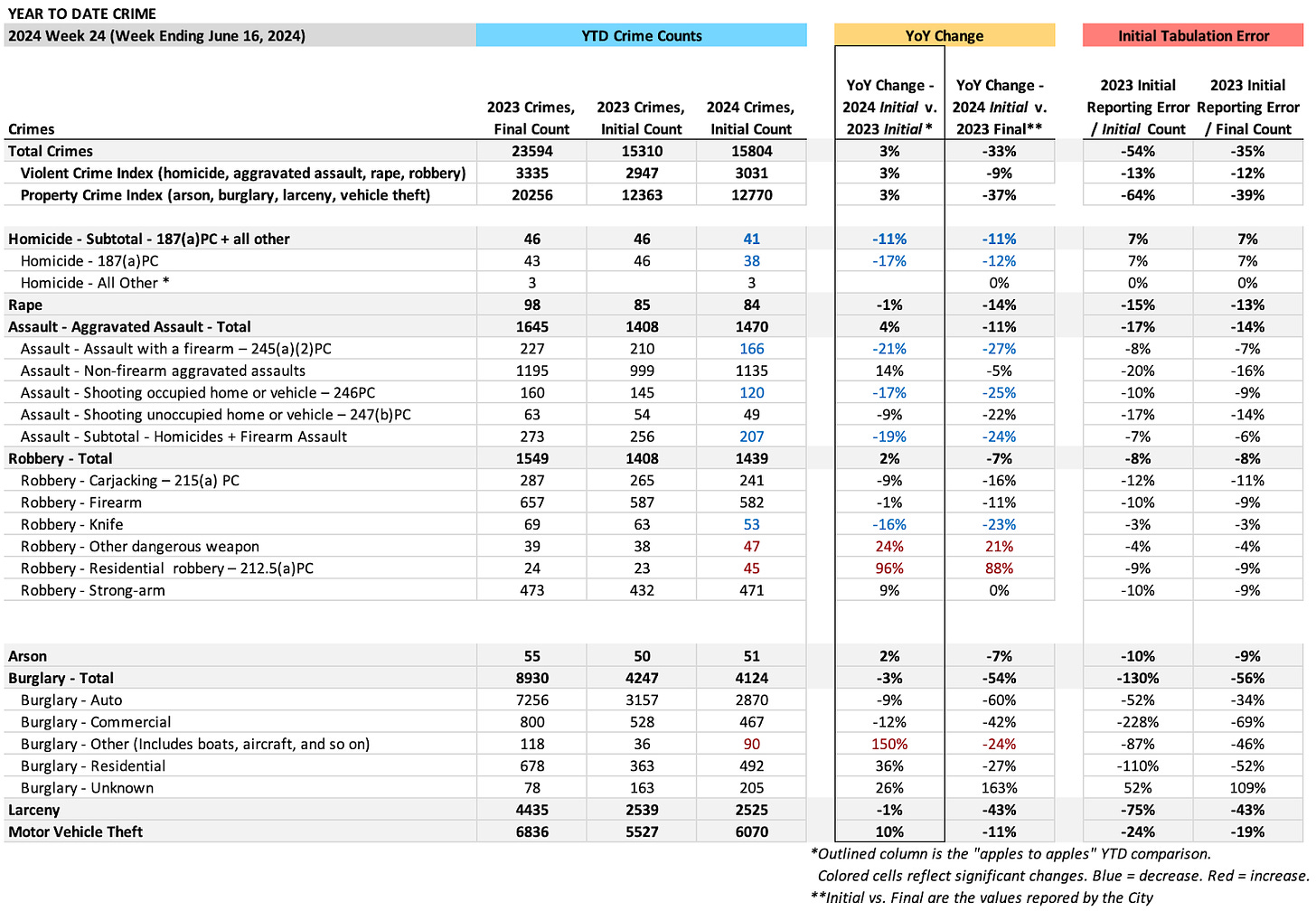






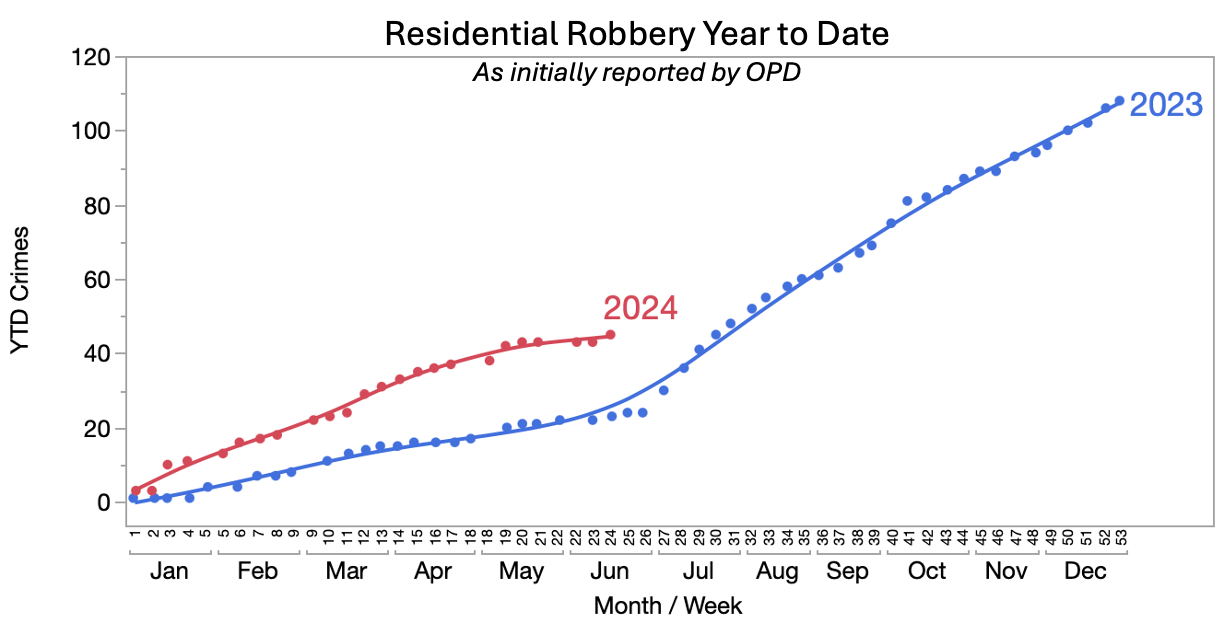
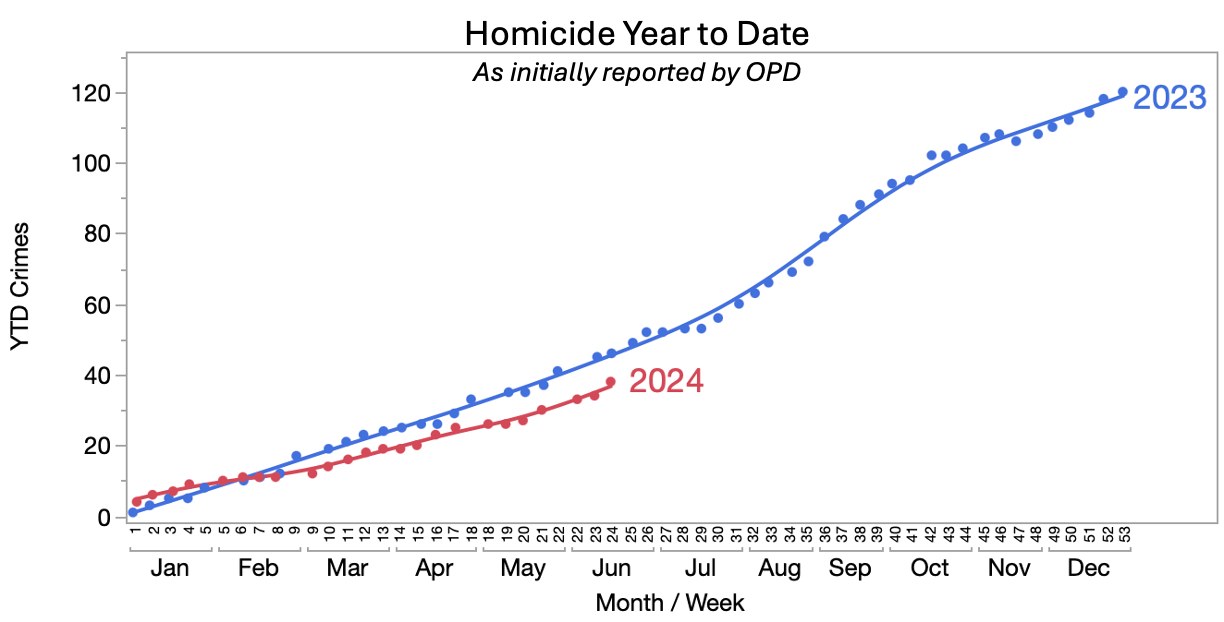
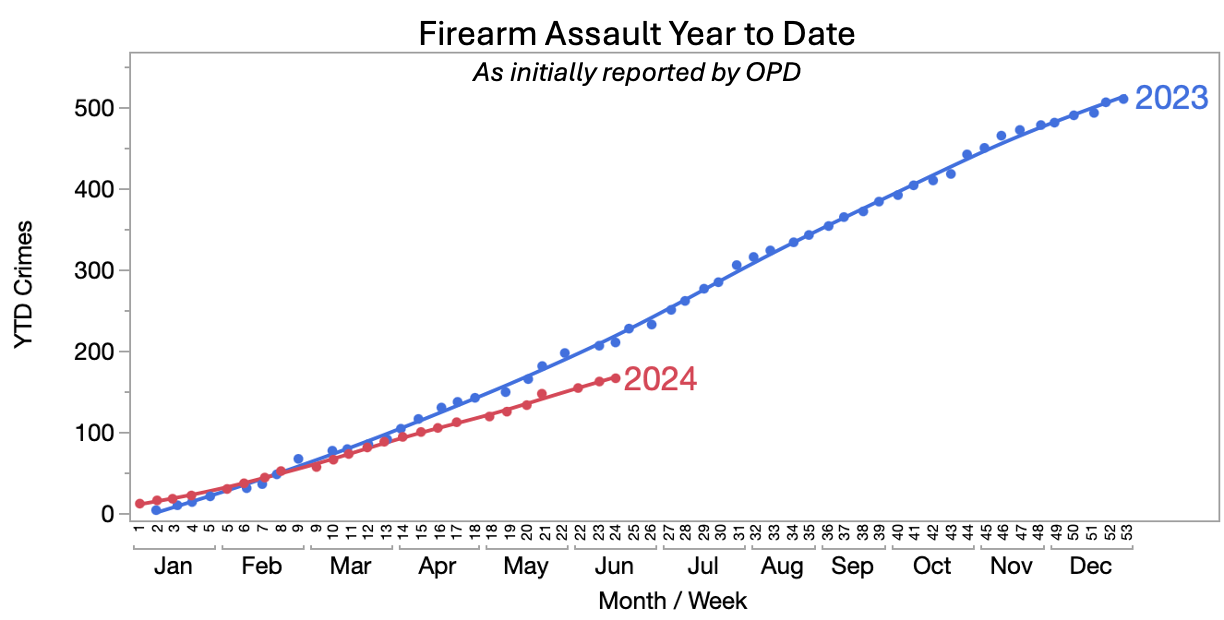
I appreciate you calling out Rebecca Kaplan's lie (via a Twitter post) about crime dropping with data that showed the decline in Shot-Spotter activations while ignoring other categories of crime (some of which have increased as you mentioned).
As always-well referenced and presented numerical data, no nonsense reporting,
thankyou for distilling the relevant information, into easily understandable format for most folks.